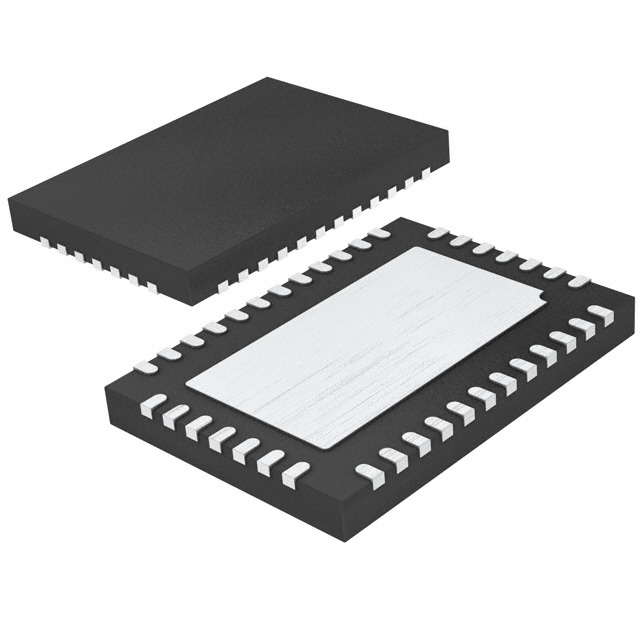ATA6616-P3PW
Product Overview
Category: Integrated Circuit (IC)
Use: ATA6616-P3PW is a high-performance, low-power LIN transceiver designed for automotive applications. It provides a reliable communication interface between microcontrollers and various automotive sensors and actuators.
Characteristics: - High-speed data transmission up to 20 kbps - Low quiescent current consumption - Robust EMC performance - Wide operating voltage range (3.0V to 18V) - Compact package size - Enhanced ESD protection
Package: The ATA6616-P3PW is available in a small footprint PowerSSO-36 package, which ensures efficient heat dissipation and easy integration into automotive electronic systems.
Essence: The ATA6616-P3PW is an essential component in automotive LIN bus networks, enabling seamless communication between different electronic control units (ECUs) within a vehicle.
Packaging/Quantity: The ATA6616-P3PW is typically sold in reels of 2500 units per reel.
Specifications
- Supply Voltage Range: 3.0V to 18V
- Operating Temperature Range: -40°C to +125°C
- Data Rate: Up to 20 kbps
- Quiescent Current Consumption: <10 µA
- ESD Protection: ±8 kV HBM (Human Body Model)
- Package Type: PowerSSO-36
Detailed Pin Configuration
The ATA6616-P3PW features the following pin configuration:
- VBAT: Supply voltage input
- GND: Ground connection
- TXD: LIN bus transmitter output
- RXD: LIN bus receiver input
- WAKE: Wake-up input
- EN: Enable input
- STB: Standby input
- ERR: Error output
- VREF: Reference voltage output
- LINH: LIN bus high-side connection
- LIND: LIN bus low-side connection 12-36: Reserved
Functional Features
- High-speed LIN communication
- Sleep mode with wake-up functionality
- Error detection and reporting
- Integrated voltage regulator for reference voltage generation
- Enhanced ESD protection for robust operation in automotive environments
Advantages and Disadvantages
Advantages: - Low power consumption - Wide operating voltage range - Compact package size - Robust EMC performance - High-speed data transmission
Disadvantages: - Limited pin configuration options - Requires external components for complete LIN network implementation
Working Principles
The ATA6616-P3PW operates as a LIN transceiver by converting the digital signals from a microcontroller into LIN bus-compatible signals. It provides bidirectional communication between the microcontroller and other LIN bus nodes, enabling control and monitoring of various automotive devices.
The transceiver utilizes advanced modulation techniques to transmit and receive data over the LIN bus. It also incorporates error detection mechanisms to ensure reliable data transfer and fault reporting.
Detailed Application Field Plans
The ATA6616-P3PW is widely used in automotive applications, including but not limited to: - Body control modules - Climate control systems - Lighting systems - Powertrain control modules - Seat control units - Steering column modules - Window lift systems
Its versatility and robustness make it suitable for integration into various electronic control units within a vehicle.
Detailed and Complete Alternative Models
- ATA6622: Similar LIN transceiver with enhanced diagnostic features.
- TJA1028: LIN transceiver with integrated voltage regulator and advanced sleep mode functionality.
- MCP2004A: Low-power LIN transceiver with integrated wake-up functionality.
These alternative models offer similar functionality and can be considered as alternatives to the ATA6616-P3PW based on specific application requirements.
Word count: 525 words
Lista 10 Vanliga frågor och svar relaterade till tillämpningen av ATA6616-P3PW i tekniska lösningar
Sure! Here are 10 common questions and answers related to the application of ATA6616-P3PW in technical solutions:
Question: What is ATA6616-P3PW?
- Answer: ATA6616-P3PW is a high-speed CAN transceiver with integrated wake-up and power management features.Question: What is the maximum data rate supported by ATA6616-P3PW?
- Answer: ATA6616-P3PW supports a maximum data rate of 5 Mbps.Question: Can ATA6616-P3PW be used in automotive applications?
- Answer: Yes, ATA6616-P3PW is suitable for automotive applications as it meets the requirements of the automotive industry.Question: Does ATA6616-P3PW support bus fault protection?
- Answer: Yes, ATA6616-P3PW provides bus fault protection, ensuring reliable communication on the CAN bus.Question: Can ATA6616-P3PW operate in low-power modes?
- Answer: Yes, ATA6616-P3PW has integrated power management features that allow it to operate in low-power modes, conserving energy.Question: Is ATA6616-P3PW compatible with other CAN transceivers?
- Answer: Yes, ATA6616-P3PW is compatible with other CAN transceivers that comply with the CAN protocol standards.Question: What is the operating voltage range of ATA6616-P3PW?
- Answer: ATA6616-P3PW operates within a voltage range of 3.0V to 5.5V.Question: Can ATA6616-P3PW be used in industrial automation applications?
- Answer: Yes, ATA6616-P3PW is suitable for industrial automation applications due to its robustness and reliability.Question: Does ATA6616-P3PW support wake-up functionality?
- Answer: Yes, ATA6616-P3PW has integrated wake-up functionality, allowing it to wake up from low-power modes upon receiving a specific signal.Question: Is ATA6616-P3PW available in different package options?
- Answer: Yes, ATA6616-P3PW is available in various package options, including TSSOP and HVSON, providing flexibility for different design requirements.
Please note that these answers are general and may vary depending on the specific implementation and use case.


